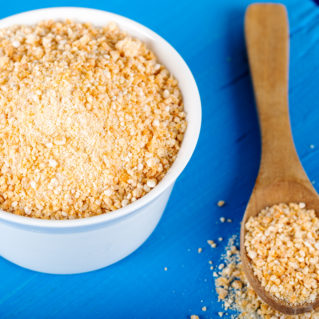Petimezi is a thick syrup, dark in colour, which is produced by boiling the must. It is mainly used as a sweetener in recipes for savoury and sweet dishes, as well as in various beverages such as tea instead of sugar.
It is often confused with must. The must is the juice produced from the grapes when we squeeze them without boiling it. Depending on the boiling time, petimezi is produced in various densities.

Nutritional value
It gathers most of the nutrients of the grape as it is rich in energy, calcium, iron, manganese and vitamin B6.
References to its nutritional properties exist from the Minoan era.
Historical facts
It is expected that there are countless references in the texts of the ancient Greeks and Romans about wine and must. We find also recipes from that time that use must and petimezi.
The ancient Greeks divided the must into three categories according to its sweetness which was due to boiling time and its thickness. The first category was the “glefkos” which resembled the fresh must from very ripe grapes. There was the “epsima”, which was the concentrated juice of the grapes, i.e. today’s petimezi. Its density was like that of honey, so it often replaced it. The third and last category is the “epsetos” which was less dense than the “epsima”.
Athenaeus of Naucratis for example, in his books mentions petimezi and the Cretan “glikina”, which is a type of bread with olive oil and must. Marcus Gavius Apicius on the other hand, mentions a sauce with boiled grape juice and raisins and a dish of pork cooked with plums in must.
Afterward, in Byzantium very popular was “oenunda” or “mustopita”, a sweet consisting of flour and boiled must. This kind of sweet is known to the modern Greeks as moustalevria.
Use in the cuisine
Sweet dishes
Petimezi is a by-product of the grape and is used as a sweetener in various beverages such as teas and infusions instead of sugar (especially in times when white sugar was considered a luxury item). It is used or for sweet syrups such as in ice creams, loukoumades, tiganites, diples, fruit salads and in yoghurts. You can also spread it on bread with butter instead of honey or jam.

In addition, it gives a special flavour to sweets, such as cakes, cookies and biscuits. It can also be used to make moustokouloura and moustaleuria.

Moreover during the Byzantine Empire, petimezi was used to prepare sweets such as pastelia, lalaggia (like tiganites), kidonopasta (quince paste) and walnut sweets. In Minor Asia it was also used to make sweets such as roasted quinces, red halva and cream with milk and petimezi. It is also used as a preservative mainly in eggplant and pumpkin spoon sweets in the traditional greek cuisine !
In Tinos, according to the tradition, they prepare fesklopita for Christmas. Fesklopita is a sweet variation of seklopita, containing petimezi, sugar, walnuts, raisins and herbs. In Samos, on the other hand, there is an traditional dish, the “chaletia”, which are served with petimezi. Chaletia are tiganites made from bobota (a sweet flour-based porridge).
Savoury dishes
We can use petimezi for vinaigrette for green salads, for marinating or even for the production of sweet and sour dishes. It can even be added to dishes with fish or even vegetables. In some islands of the Ionean sea and the Cyclades they make the spicy savoro sauce. This sauce in some variations contains petimezi, and accompanies small fried fish such as mullets and bogues.

Finally, petimezi gives to meat a sweet and spicy taste, while it binds and caramelizes the sauces in which it participates. You can glaze pork or chicken and make a roast in the oven using steaks or ribs !




